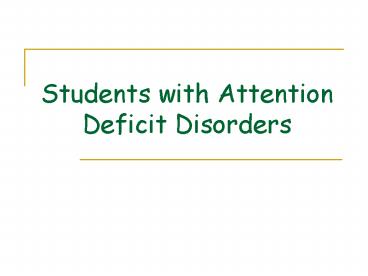Students with Attention Deficit Disorders - PowerPoint PPT Presentation
1 / 20
Title:
Students with Attention Deficit Disorders
Description:
Title: Chapter 5 Teaching Students With Learning Disabilities or Attention Deficit Disorders Author: Sarah Summy Last modified by: Susan Cherup Created Date – PowerPoint PPT presentation
Number of Views:248
Avg rating:3.0/5.0
Title: Students with Attention Deficit Disorders
1
Students with Attention Deficit Disorders
2
Students with ADHD may be serviced under IDEA
- Under other health impairment
- having limited strength, vitality or
alertness, including a heightened alertness to
environment stimuli, that results in limited
alertness with respect to the educational
environment that is due to health problems such
as.attention deficit disorder or attention
deficit hyperactivity disorder.. That adversely
affects a childs educational performance
3
Students may be serviced under Section 504
Civil Rights Statute
- Eligibility is based on the existence of an
identified physical condition that substantially
limits a major life activity. If it is
determined that the ADHD limits a students
ability to learn, he/she meets the criteria.
4
Comparison of Section 504 IDEA
- 504 focuses on equity and access in ALL areas of
life but does not detail how services will be
provided. - IDEA mandates procedures for identifying students
with disabilities and how services should be
provided and monitored.
5
How is ADHD Diagnosed?
- Only a licensed professional (pediatrician,
psychologist, neurologist, or psychiatrist) - However, usually, these professionals ask for
help from the school district personnel
6
Recommended Diagnostic Procedure
- Thorough medical and family history
- Medical examination
- Comprehensive interview with parents, teachers of
the child - Behavior rating scales (standardized)
- Observation of child
- IQ testing and social and emotional adjustment
testing (check for LD)
7
Connors Rating Scale
- You, as a general education teacher will be asked
to do an assessment on the student.
8
- Not all children and youth have the same type
of ADHD. Because the disorder varies among
individuals, students with ADHD wont all have
the same problems. However, they will have
problems in one of the three areas.attention,
hyperactivity, and impulsivity.
9
DSM-IV
- Breaks it down into categories
- (1) ADHD Inattentive Type
- (2) ADHD-Hyperactive-Impulsive
- (3) ADHD-Combined
10
Attention Deficit Disorders
- Inattention refers to consistent (over 6 months)
and highly inappropriate levels of the following
behaviors Must display six or more. - Failing to pay close attention to details, making
careless mistakes inconsistent with the childs
developmental level - Failing to sustain attention to tasks and/or
activities - Failing to listen
- Failing to complete tasks
- Having difficulty with organization
- Resisting tasks that require sustained attention
- Losing materials and objects
- Becoming easily distracted
- Being forgetful
11
Hyperactivity-Impulsivity
- Must be consistent (over six months) and highly
inappropriate levels of the following behaviors - Fidgeting or squirming
- Having a difficult time remaining seated during
class - Running or climbing excessively when it is
inappropriate - Having difficulty playing quietly
- Acting as though he or she is driven by a motor
- Talking too much
- Blurting out answers
- Difficulty waiting for their turn
- Interrupting others or butting into activities
- Students must display six or more of the
preceding characteristics to be identified with
hyperactivity-impulsivity
12
ADHD-Combined
- Students who have features of both inattention
and hyperactivity-impulsivity
13
Common features that distinguish ADHD from mild
attention of hyperactive problems
- Onset in early childhood
- Chronic over time
- Generally pervasive across situations
- Deviant from age-based standards
14
Remember.
- Present before the age of 7
- Shows in two (or more) settings
15
Prevalence
- 3-7 out of every 100 school age children
(American Psychiatric Association, 2000) - Males more than females ( 4 to 1)
16
Educational Interventions
- Provide organizational assistance
- Provide rewards consistently and often
- Be brief and clear
- Arrange the environment to facilitate attention
- Allow for movement and postures other than
sitting - Use novelty in instruction and directions
- Maintain a schedule
- Prepare students for transitions
- Emphasize time limits
17
Assistive Technology
- Highlighters
- Stress balls
- Books on tape and headsets to block out
distraction - Play Attention Helmet
- Handheld with schedule
18
Medication
- Ritalin
- Dopamine
- Concerta
- One component of the overall treatment of ADHD
19
Web sites
- www.chadd.org for Children and Adults with
Attention Deficit/Hyperactivity Disorder - www.add.org provides information about
individuals with ADHD, with particular empasis on
adults with ADHD - www.nichd.nih.gov provides information and
research on specific learning disabilities and
ADHD - www.ldonline.org the ADD/ADHD section links to
articles and resources on topics including facts
and myths, firls with ADHD, diagnosis, treatment,
and medications
20
Source
- Information from TEACHING STUDENTS WHO ARE
EXCEPTIONAL, DIVERSE, AND AT RISK IN THE GENERAL
EDUCATION CLASSROOM by Sharon Vaughn, Candace S.
Bos, and Jeanne Shay Schumm































